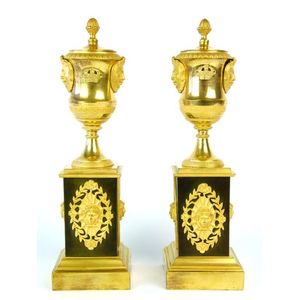Louis XVI Cassolettes, 18th Century, French
You must be a subscriber, and be logged in to view price and dealer details.
Subscribe Now to view actual auction price for this item
When you subscribe, you have the option of setting the currency in which to display prices to $Au, $US, $NZ or Stg.
- Ormolu - Ormolu was popular with French craftsmen in the 18th and 19th century for ornamental fittings for furniture, clocks and other decorative items. True ormolu is gilt bronze, that is bronze that has been coated with gold using a mercury amalgam. Due to the health risks associated with using mercury, this method of creating ormolu was discontinued in France in the 1830s. A substitute was developed consisting of about 75% copper and 25% zinc, however it was inferior to the bronze version. It was often lacquered to prevent it tarnishing.
- Cassolette - The origins of the cassolette date back to medieval times, where they were commonly used to serve stews and other hot dishes at banquets and other formal occasions. In the 18th century, cassolette dishes began to be made from porcelain and were often decorated with ornate designs, making them popular as decorative pieces as well as functional serving dishes.
During the 19th century, cassolette dishes became popular in French cuisine, where they were used to prepare and serve dishes such as cassolette de fruits de mer, a seafood stew, and cassolette de gibier, a game stew. - Bronze - An alloy of copper and tin, traditionally in the proportions of about 9 parts of copper to 1 part of tin.
The discovery of bronze in Western Asia in the 4th century enabled people to create metal objects which were superior to those previoulsy possible because of its strength and hardness, and it has been used throughout the world for weapons, coins, tools, statuary and other decorative items.
It is very fluid in a molten state, and its hardness, strength when set, and non-corrosive properties makes it most suitable for casting sculpture.
This item has been included into following indexes:
Visually similar items

Phillipe Mourey gilt clock garniture having painted porcelain panels featuring classical courting scenes & cherubs, with the movement stamped 'Gf', with a key & pendulum. Condition: good to fair, some loose pieces, needs a service. Height 33.5 cm

A pair of French Sevres style tall porcelain vases, late 19th century the sides with an oval painted panel depicting a courting couple, signed 'E. Carelle' and a landscape panel to the reverse, cobalt blue field with gilt embellishments and gilt metal scro

Pair of gilt metal and porcelain two stick candlesticks, approx 25 cm high

An early 19th century French Empire white marble and ormolu clock garniture C. 1810, the 8-day-barrel-movement fitted to a reeded column with gilt festoons and swags, the white marbleside urns with ram's head, tripod legs, hoof feet and acorn bowls with pi
